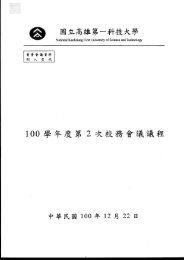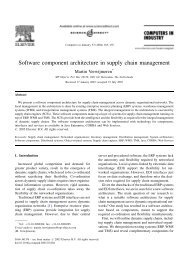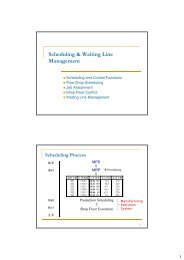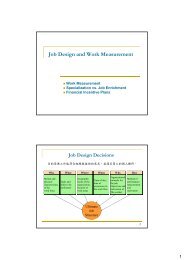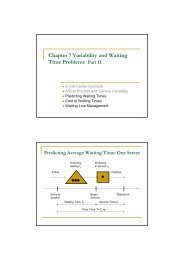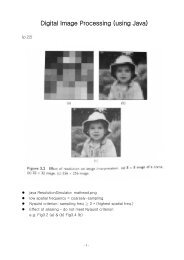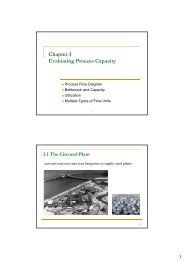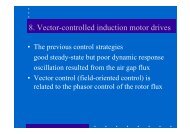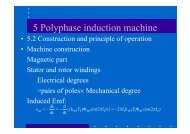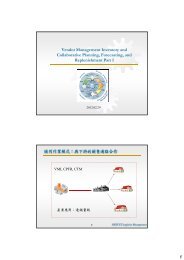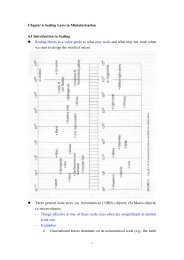Chapter 9 Variability and Throughput Losses
Chapter 9 Variability and Throughput Losses
Chapter 9 Variability and Throughput Losses
- No tags were found...
Create successful ePaper yourself
Turn your PDF publications into a flip-book with our unique Google optimized e-Paper software.
2013/4/21<strong>Chapter</strong> 9<strong>Variability</strong> <strong>and</strong> <strong>Throughput</strong> <strong>Losses</strong>• A Barber Shop Example• <strong>Throughput</strong> Loss for a Trauma Center• Customer Impatience• Serial Systems <strong>and</strong> Buffers9.1 Why Averages Do Not Work• Customer arrivals in one hour: 0, 1, or 2.• Service times vary. The server may leave temporarily.Serve 0, 1, or 2 customers in one hour.• Assume no customer waits.21
2013/4/219.2 <strong>Throughput</strong> Loss for a Trauma Center3 trauma baysTrauma center moves todiversion status once all serversare busy (incoming patients aredirected to other locations)39.3 Analyzing the Trauma Center• A service system with parallel resources <strong>and</strong> no waitingroom.• Three trauma bays. m=3• On average, a new patient arrives every a=3 hours.• The average time of treatment is p=2 hours.Capacity 32 hours/patient 1.5 patients/hourImplied utilization0.3333 patients/hour 0.22221.5 patients/hour42
2013/4/21Analyzing Loss Systems: Finding P m (r)The percent of the time the trauma center has to go on diversion status• Define r =p / a• r= 2 hours/ 3 hours=0.67• Recall m=3• Use Erlang Loss Table• Find P 3 (0.67)=0.0255r = p / am1 2 3 4 50.10 0.0909 0.0045 0.0002 0.0000 0.00000.20 0.1667 0.0164 0.0011 0.0001 0.00000.25 0.2000 0.0244 0.0020 0.0001 0.00000.30 0.2308 0.0335 0.0033 0.0003 0.00000.33 0.2500 0.0400 0.0044 0.0004 0.00000.40 0.2857 0.0541 0.0072 0.0007 0.00010.50 0.3333 0.0769 0.0127 0.0016 0.00020.60 0.3750 0.1011 0.0198 0.0030 0.00040.67 0.4000 0.1176 0.0255 0.0042 0.00060.70 0.4118 0.1260 0.0286 0.0050 0.00070.75 0.4286 0.1385 0.0335 0.0062 0.00090.80 0.4444 0.1509 0.0387 0.0077 0.00120.90 0.4737 0.1757 0.0501 0.0111 0.00201.00 0.5000 0.2000 0.0625 0.0154 0.00315Evaluate System Performance based on P m6Given P m (r) we can compute:• Amount of time the trauma center has to go ondiversion status <strong>and</strong> turn away patientsP m (r)24 = 0.025524 = 0.6 hours per day• Patients lost = 1/aP m (r) = 1/3240.0255 = 0.2 per dayServices with high uncertainty <strong>and</strong> stakes require morecapacity → low utilization3
2013/4/21Implied Utilization vs. Prob. of All Servers BusyP m does not depend on the CV of service timesProbabilitythat all serversare utilized0.60.50.40.3m=1m=20.20.10m=3 m=5 m=10m=200 0.1 0.2 0.3 0.4 0.5 0.6 0.7 0.8 0.9 1 1.1Implied utilization79.4 Limited Buffer Size <strong>and</strong> <strong>Throughput</strong> Loss• In a call center, there is a maximum number of callsthat can be hold simultaneously. You cannot get intothe queue if you get a busy signal.• A larger buffer size means fewer customers will beturned away.• The buffer size is proportional to the maximum waitingtime for the last customer in the queue.84
2013/4/21Increasing the buffer size can reduce the throughput loss at acost of more WIP or waiting timesImpact the Probability P mProbability thatsystem is full, P m0.50.40.30.2Increasing levelsof utilization0.101 2 3 4 5 6 7 8 9 1011Size of the buffer spaceof Buffer Size on9Percentageof dem<strong>and</strong> served100806040200Decreasing levelsof utilization1 2 3 4 5 6 7 8 9 10 11Size of the buffer spaceWaiting Time <strong>and</strong> Customer Impatience• arrive, view, <strong>and</strong> leave (balking)• arrive, wait awhile, <strong>and</strong> leave (reneging)Fraction ofcustomer lostAverage wait time [seconds]105
2013/4/21Reducing Waiting Time <strong>and</strong> Customer Loss• Having customers wait <strong>and</strong> leave (reneging) is evenworse than having customers leave immediately (balking).• Increasing the buffer size may increase the number ofreneging customers.• Reduce wait times by intelligently adjusting capacity orreducing variability.• Increase the customers’ willingness to tolerate waiting.Giving customers meaningful tasks to do.Creating a environment where waiting is not too painful.Communicate the expected waiting time upfront to the customer.119.5 Serial Service Systems with <strong>Variability</strong>• Each flow unit must go through all steps in the samesequence. (a flow line)• <strong>Variability</strong> of the second step comes from variability ofthe arrival process, variability of service times at the firststep, <strong>and</strong> variability of service times at the second step.InflowOutflow of resource 1 =Inflow of resource 2OutflowUpstreamDownstream126
2013/4/21The Concepts of Blocking <strong>and</strong> StarvingA resource is blocked if it is unable to release the flow unit it has justserved because there is no space available in the downstream step.InflowActivitycompletedResource is blockedOutflowInflowOutflowActivity notyet completedEmpty space for a flow unitResource is starvedSpace for a flow unit with a flow unitin the space13The Snowball Effect of Blocking• Consider a patient who is ready to be discharged fromthe general care unit at 11am. Now the patient decidesto leave at 5pm.PatientsTraumabayResource is blockedICUGeneral CareDischarge• Hospitals introduce discharge rooms for such patients.147
2013/4/21Create Robust Processes to H<strong>and</strong>le <strong>Variability</strong>• Flexible workforce or adjustable capacity.• Add buffers at the expense of long wait times• Sales does not equal dem<strong>and</strong>. Keep track oflost dem<strong>and</strong>.• Assign less time-critical work as backgroundwork to improve productivity.15Summary• <strong>Variability</strong> leads to waiting customers,dissatisfaction, <strong>and</strong> revenue losses.• Reduce variability wherever possible.• Since we cannot eliminate variability entirely,we should design robust processes toaccommodate the remaining variability.168



